A Bifunctional BiOBr/ZIF-8/ZnO Photocatalyst with Rich Oxygen Vacancy for Enhanced Wastewater Treatment and H2O2 Generation
Abstract
:1. Introduction
2. Results and Discussion
2.1. Characterization
2.2. The Degradation of Wastewater
2.3. Photocatalytic H2O2 Evolution and Possible Mechanism
2.4. Mechanism Discussion
3. Experimental Section
3.1. Preparation of ZIF-8 Catalyst
3.2. Preparation of BiOBr/ZIF-8/ZnO Catalyst
3.3. Characterization and Photocatalysis Experiment
4. Conclusions
Supplementary Materials
Author Contributions
Funding
Institutional Review Board Statement
Informed Consent Statement
Data Availability Statement
Acknowledgments
Conflicts of Interest
References
- Wu, Y.H.; Li, C.; Tian, Z.; Sun, J. Solar-driven integrated energy systems: State of the art and challenges. J. Power Sources 2020, 478, 228762. [Google Scholar] [CrossRef]
- Kormann, C.; Bahnemann, D.W.; Hoffmann, M.R. Photocatalytic production of hydrogen peroxides and organic peroxides in aqueous suspensions of titanium dioxide, zinc oxide, and desert sand. Environ. Sci. Technol. 1988, 22, 798–806. [Google Scholar] [CrossRef] [PubMed]
- Yoon, M.; Oh, Y.; Hong, S.; Lee, J.S.; Boppella, R.; Kim, S.H.; Mota, F.M.; Kim, S.O.; Kim, D.H. Synergistically enhanced photocatalytic activity of graphitic carbon nitride and WO3 nanohybrids mediated by photo-Fenton reaction and H2O2. Appl. Catal. B Environ. 2017, 206, 263–270. [Google Scholar] [CrossRef]
- Zhao, S.; Zhao, X.; Zhang, H.; Li, J.; Zhu, Y. Covalent combination of polyoxometalate and graphitic carbon nitride for light-driven hydrogen peroxide production. Nano Energy 2017, 35, 405–414. [Google Scholar] [CrossRef]
- Zhang, L.; Zhang, J.; Zeng, G.; Dong, H.; Chen, Y.; Huang, C.; Zhu, Y.; Xu, R.; Cheng, Y.; Hou, K.; et al. Multivariate relationships between microbial communities and environmental variables during co-composting of sewage sludge and agricultural waste in the presence of PVP-AgNPs. Bioresour. Technol. 2018, 261, 10–18. [Google Scholar] [CrossRef]
- Wu, Y.; Ding, Y.; Han, X.; Li, B.; Wang, Y.; Dong, S.; Li, Q.; Dou, S.; Sun, J.; Sun, J. Modulating coordination environment of Fe single atoms for high-efficiency all-pH-tolerated H2O2 electrochemical production. Appl. Catal. B Environ. 2022, 315, 121578. [Google Scholar] [CrossRef]
- Jourshabani, M.; Asrami, M.R.; Lee, B.K. An efficient and unique route for the fabrication of highly condensed oxygen-doped carbon nitride for the photodegradation of synchronous pollutants and H2O2 production under ambient conditions. Appl. Catal. B Environ. 2022, 302, 120839. [Google Scholar] [CrossRef]
- Wang, Y.; Meng, D.; Zhao, X. Visible-light-driven H2O2 production from O2 reduction with nitrogen vacancy-rich and porous graphitic carbon nitride. Appl. Catal. B Environ. 2020, 273, 119064. [Google Scholar] [CrossRef]
- Ma, J.; Wang, K.; Wang, C.; Chen, X.; Zhu, W.; Zhu, G.; Yao, W.; Zhu, Y. Photocatalysis-self-Fenton system with high-fluent degradation and high mineralization ability. Appl. Catal. B Environ. 2020, 276, 119150. [Google Scholar] [CrossRef]
- Dong, S.; Liu, X.; Tian, G.; Wang, Y.; Jin, G.; Zhao, Y.; Sun, J.; Fan, M. Surface oxygen vacancies modified Bi2MoO6 double-layer spheres: Enhanced visible LED light photocatalytic activity for ciprofloxacin degradation. J. Alloys Compd. 2022, 892, 162217. [Google Scholar] [CrossRef]
- Zhang, Y.; Qiu, J.; Zhu, B.; Fedin, M.V.; Cheng, B.; Yu, J.; Zhang, L. ZnO/COF S-scheme heterojunction for improved photocatalytic H2O2 production performance. Chem. Eng. J. 2022, 444, 136584. [Google Scholar] [CrossRef]
- Du, C.; Feng, W.; Nie, S.; Su, X.; Liu, H.; Feng, J.; Sun, J.; Hu, C.; Dong, S. π-π conjugation driving degradation of aromatic compounds with in-situ hydrogen peroxide generation over Zn2In2S5 grown on nitrogen-doped carbon spheres. Appl. Catal. B Environ. 2022, 310, 121298. [Google Scholar] [CrossRef]
- Sun, J.; Jiang, C.; Wu, Z.; Liu, Y.; Sun, S. A review on the progress of the photocatalytic removal of refractory pollutants from water by BiOBr-based nanocomposites. Chemosphere 2022, 308, 136107. [Google Scholar] [CrossRef] [PubMed]
- Deng, C.; Wang, T.; Ye, F.; Ling, X.; Peng, L.; Hu, H.; Yu, H.; Ding, K.; Wu, Y.; Dong, Q.; et al. Construction of 0D/2D CuO/BiOBr hierarchical heterojunction for the enhanced photocatalytic degradation of benzene-containing pollutants under visible light. J. Environ. Chem. Eng. 2022, 10, 107365. [Google Scholar] [CrossRef]
- Liu, C.; Mao, S.; Shi, M.; Hong, X.; Wang, D.; Wang, F.; Xia, M.; Chen, Q. Enhanced photocatalytic degradation performance of BiVO4/BiOBr through combining Fermi level alteration and oxygen defect engineering. Chem. Eng. J. 2022, 449, 137757. [Google Scholar] [CrossRef]
- Chuaicham, C.; Sekar, K.; Balakumar, V.; Uchida, J.; Katsurao, T.; Sakabe, H.; Ohtani, B.; Sasaki, K. Efficient photocatalytic degradation of emerging ciprofloxacin under visible light irradiation using BiOBr/carbon quantum dot/saponite composite. Environ. Res. 2022, 212, 113635. [Google Scholar] [CrossRef]
- Wu, Y.; Ji, H.; Liu, Q.; Sun, Z.; Li, P.; Ding, P.; Guo, M.; Yi, X.; Xu, W.; Wang, C.C.; et al. Visible light photocatalytic degradation of sulfanilamide enhanced by Mo doping of BiOBr nanoflowers. J. Hazard. Mater. 2022, 424, 127563. [Google Scholar] [CrossRef]
- Rowsell, J.L.C.; Yaghi, O.M. Metal-organic frameworks: A new class of porous materials. Microporous Mesoporous Mater. 2004, 73, 3–14. [Google Scholar] [CrossRef]
- Dai, H.; Yuan, X.; Jiang, L.; Wang, H.; Zhang, J.; Zhang, J.; Xiong, T. Recent advances on ZIF-8 composites for adsorption and photocatalytic wastewater pollutant removal: Fabrication, applications and perspective. Coord. Chem. Rev. 2021, 441, 213985. [Google Scholar] [CrossRef]
- Yang, X.; Wen, Z.; Wu, Z.; Luo, X. Synthesis of ZnO/ZIF-8 hybrid photocatalysts derived from ZIF-8 with enhanced photocatalytic activity. Inorg. Chem. Front. 2018, 5, 687–693. [Google Scholar] [CrossRef]
- Zhou, J.; Liu, W.; Cai, W. The synergistic effect of Ag/AgCl@ZIF-8 modified g-C3N4 composite and peroxymonosulfate for the enhanced visible-light photocatalytic degradation of levofloxacin. ScTEn 2019, 696, 133962. [Google Scholar] [CrossRef] [PubMed]
- Qiu, J.; Zhang, X.F.; Zhang, X.; Feng, Y.; Li, Y.; Yang, L.; Lu, H.; Yao, J. Constructing Cd0.5Zn0.5S@ZIF-8 nanocomposites through self-assembly strategy to enhance Cr(VI) photocatalytic reduction. J. Hazard. Mater. 2018, 349, 234–241. [Google Scholar] [CrossRef]
- Wang, A.; Ni, J.; Wang, W.; Wang, X.; Liu, D.; Zhu, Q. MOF-derived N-doped ZnO carbon skeleton@hierarchical Bi2MoO6 S-scheme heterojunction for photodegradation of SMX: Mechanism, pathways and DFT calculation. J. Hazard. Mater. 2022, 426, 128106. [Google Scholar] [CrossRef] [PubMed]
- Liu, J.; Li, R.; Zu, X.; Zhang, X.; Wang, Y.; Wang, Y.; Fan, C. Photocatalytic conversion of nitrogen to ammonia with water on triphase interfaces of hydrophilic-hydrophobic composite Bi4O5Br2/ZIF-8. Chem. Eng. J. 2019, 371, 796–803. [Google Scholar] [CrossRef]
- Zhu, Y.; Xv, Q.; Wang, D.; Sun, B.; Wang, Y.; Han, Z.; Gou, Y.; Liu, J.; Li, B. Construction of a hollow BiOI/TiO2/ZIF-8 heterojunction: Enhanced photocatalytic performance for norfloxacin degradation and mechanistic insight. J. Alloys Compd. 2022, 914, 165326. [Google Scholar] [CrossRef]
- Zhang, X.; Yuan, N.; Chen, T.; Li, B.; Wang, Q. Fabrication of hydrangea-shaped Bi2WO6/ZIF-8 visible-light responsive photocatalysts for degradation of methylene blue. Chemosphere 2022, 307, 135949. [Google Scholar] [CrossRef] [PubMed]
- Wu, S.C.; Chen, Y.; Yan, X.; Guo, X.J.; Lang, W.Z. ZIF-8 channeled and coordination-bridging two-dimensional WS2 membrane for efficient organic solvent nanofiltration. Chem. Eng. J. 2022, 442, 136139. [Google Scholar] [CrossRef]
- Zheng, H.B.; Wu, D.; Wang, Y.L.; Liu, X.P.; Gao, P.Z.; Liu, W.; Wen, J.; Rebrov, E.V. One-step synthesis of ZIF-8/ZnO composites based on coordination defect strategy and its derivatives for photocatalysis. J. Alloys Compd. 2020, 838, 155219. [Google Scholar] [CrossRef]
- Du, C.; Nie, S.; Zhang, C.; Wang, T.; Wang, S.; Zhang, J.; Yu, C.; Lu, Z.; Dong, S.; Feng, J.; et al. Dual-functional Z-scheme CdSe/Se/BiOBr photocatalyst: Generation of hydrogen peroxide and efficient degradation of ciprofloxacin. J. Colloid Interface Sci. 2022, 606, 1715–1728. [Google Scholar] [CrossRef]
- Du, C.; Feng, W.; Nie, S.; Zhang, J.; Liang, Y.; Han, X.; Wu, Y.; Feng, J.; Dong, S.; Liu, H.; et al. Harnessing efficient in-situ H2O2 production via a KPF6/BiOBr photocatalyst for the degradation of polyethylene. Sep. Purif. Technol. 2021, 279, 119734. [Google Scholar] [CrossRef]
- Zhang, Z.; Chen, Y.; Hu, C.; Zuo, C.; Wang, P.; Chen, W.; Ao, T. Efficient removal of tetracycline by a hierarchically porous ZIF-8 metal organic framework. Environ. Res. 2021, 198, 111254. [Google Scholar] [CrossRef]
- Motamedi, M.; Mohammadkhah, S.; Ramezanzadeh, M.; Eivaz Mohammadloo, H.; Ramezanzadeh, B. Designing Hybrid Mesoporous Pr/Tannate-Inbuilt ZIF8-Decorated MoS2 as Novel Nanoreservoirs toward Smart pH-Triggered Anti-corrosion/Robust Thermomechanical Epoxy Nanocoatings. ACS Appl. Mater. Interfaces 2022, 14, 31170–31193. [Google Scholar] [CrossRef]
- Mahmoodi, N.M.; Oveisi, M.; Taghizadeh, A.; Taghizadeh, M. Novel magnetic amine functionalized carbon nanotube/metal-organic framework nanocomposites: From green ultrasound-assisted synthesis to detailed selective pollutant removal modelling from binary systems. J. Hazard. Mater. 2019, 368, 746–759. [Google Scholar] [CrossRef] [PubMed]
- Troyano, J.; Carne-Sanchez, A.; Avci, C.; Imaz, I.; Maspoch, D. Colloidal metal-organic framework particles: The pioneering case of ZIF-8. Chem. Soc. Rev. 2019, 48, 5534–5546. [Google Scholar] [CrossRef]
- Xu, H.; Zhu, S.; Lu, K.; Jia, H.; Xia, M.; Wang, F. Preparation of hierarchically floral ZIF-8 derived carbon@polyaniline@Ni/Al layered double hydroxides composite with outstanding removal phenomenon for saccharin. Chem. Eng. J. 2022, 450, 138127. [Google Scholar] [CrossRef]
- Zhang, Z.; Chen, Y.; Wang, P.; Wang, Z.; Zuo, C.; Chen, W.; Ao, T. Facile fabrication of N-doped hierarchical porous carbons derived from soft-templated ZIF-8 for enhanced adsorptive removal of tetracycline hydrochloride from water. J. Hazard. Mater. 2022, 423, 127103. [Google Scholar] [CrossRef]
- Jo, W.K.; Moru, S.; Tonda, S. A green approach to the fabrication of a TiO2/NiAl-LDH core-shell hybrid photocatalyst for efficient and selective solar-powered reduction of CO2 into value-added fuels. J. Mater. Chem. A 2020, 8, 8020–8032. [Google Scholar] [CrossRef]
- Dong, S.; Cui, L.; Tian, Y.; Xia, L.; Wu, Y.; Yu, C.F.; Sun, J.; Fan, M. A novel and high-performance double Z-scheme photocatalyst ZnO-SnO2-Zn2SnO4 for effective removal of the biological toxicity of antibiotics. J. Hazard. Mater. 2020, 399, 123017. [Google Scholar] [CrossRef] [PubMed]
- Ou, H.S.; Wei, C.H.; Mo, C.H.; Wu, H.Z.; Ren, Y.; Feng, C.H. Novel insights into anoxic/aerobic1/aerobic2 biological fluidized-bed system for coke wastewater treatment by fluorescence excitation-emission matrix spectra coupled with parallel factor analysis. Chemosphere 2014, 113, 158–164. [Google Scholar] [CrossRef]
- Zhang, Q.; Du, R.; Tan, C.; Chen, P.; Yu, G.; Deng, S. Efficient degradation of typical pharmaceuticals in water using a novel TiO2/ONLH nano-photocatalyst under natural sunlight. J. Hazard. Mater. 2021, 403, 123582. [Google Scholar] [CrossRef]
- Wu, Y.; Wang, F.; Jin, X.; Zheng, X.; Wang, Y.; Wei, D.; Zhang, Q.; Feng, Y.; Xie, Z.; Chen, P.; et al. Highly active metal-free carbon dots/g-C3N4 hollow porous nanospheres for solar-light-driven PPCPs remediation: Mechanism insights, kinetics and effects of natural water matrices. Water Res. 2020, 172, 115492. [Google Scholar] [CrossRef] [PubMed]
- Yu, Y.; Chen, D.; Xu, W.; Fang, J.; Sun, J.; Liu, Z.; Chen, Y.; Liang, Y.; Fang, Z. Synergistic adsorption-photocatalytic degradation of different antibiotics in seawater by a porous g-C3N4/calcined-LDH and its application in synthetic mariculture wastewater. J. Hazard. Mater. 2021, 416, 126183. [Google Scholar] [CrossRef] [PubMed]

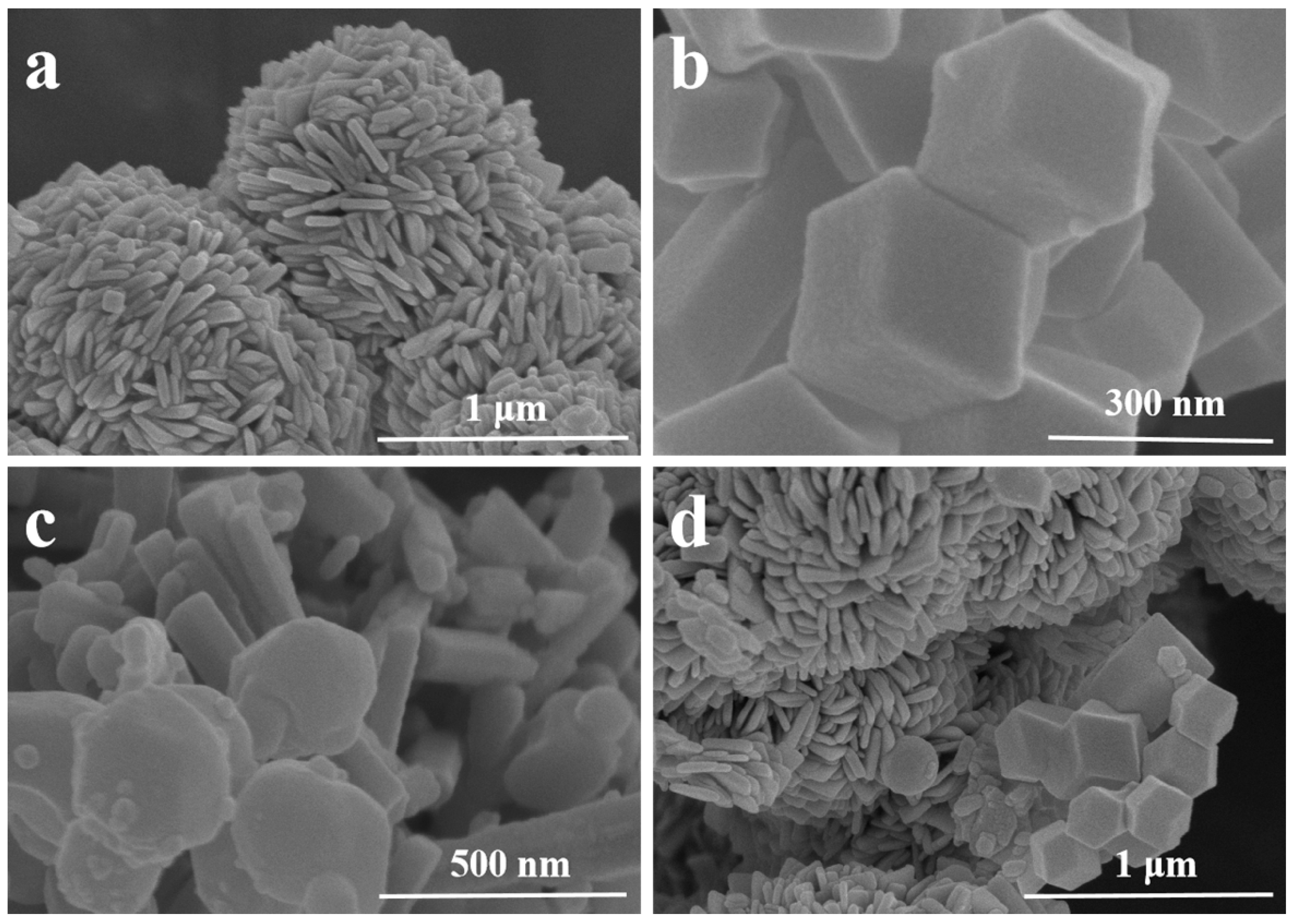
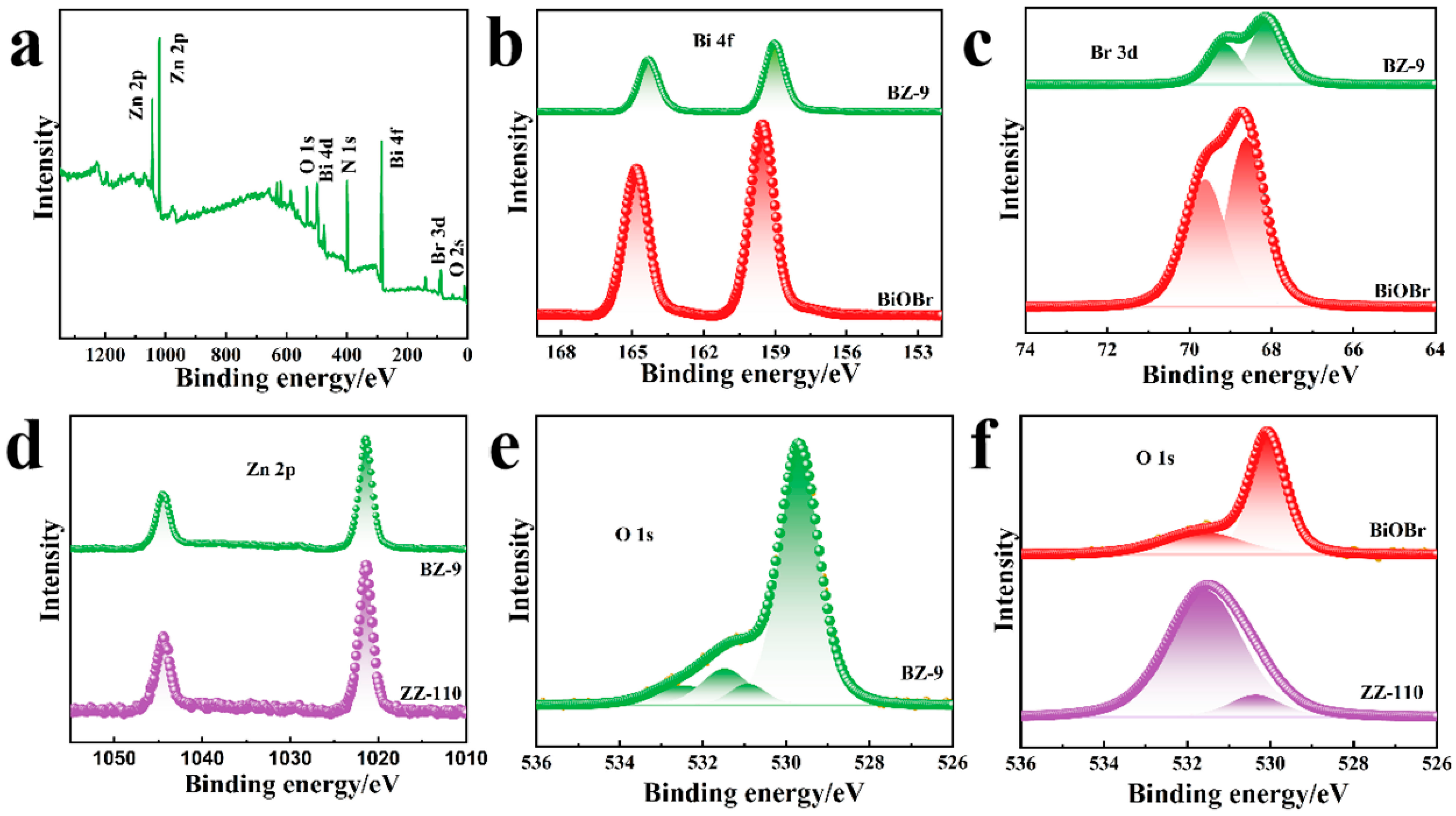


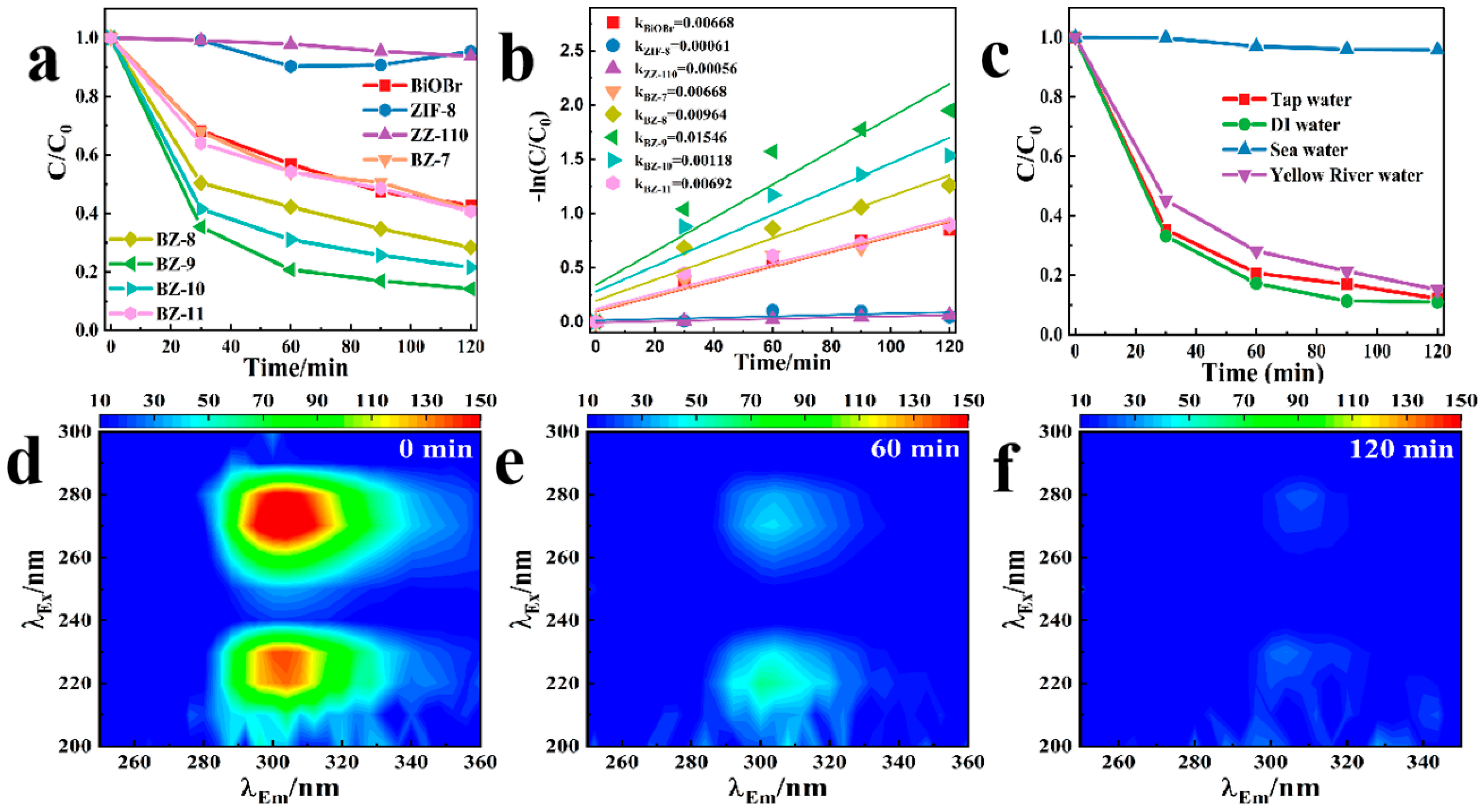
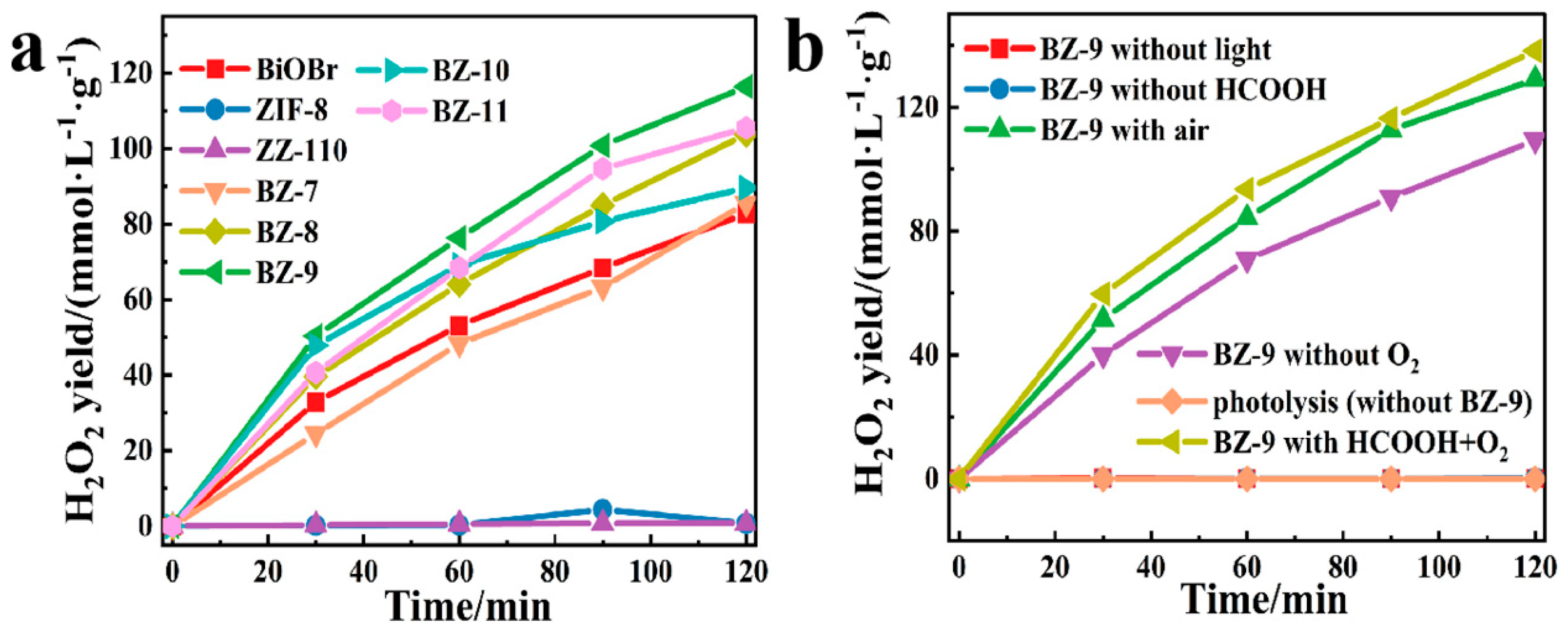
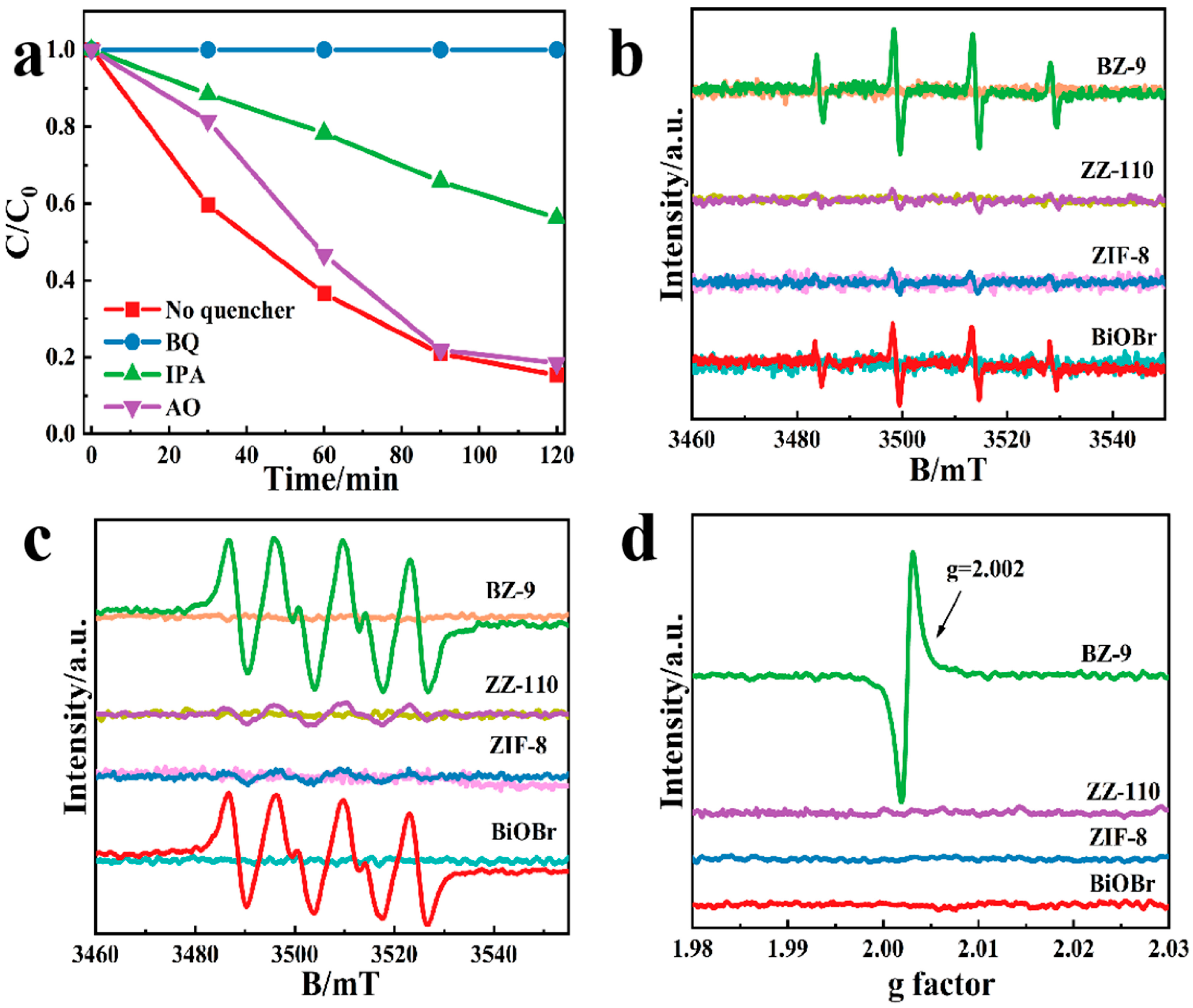
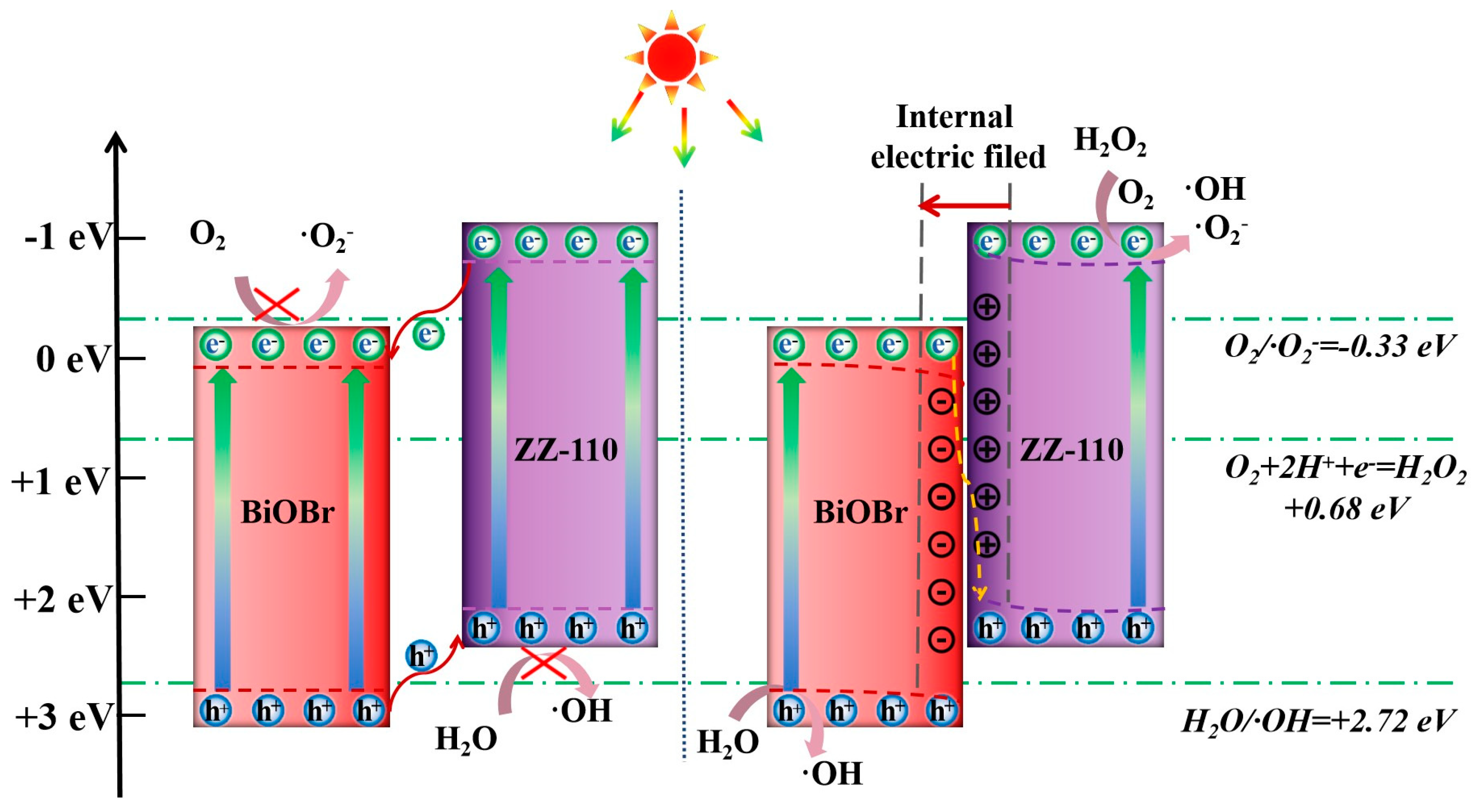

Disclaimer/Publisher’s Note: The statements, opinions and data contained in all publications are solely those of the individual author(s) and contributor(s) and not of MDPI and/or the editor(s). MDPI and/or the editor(s) disclaim responsibility for any injury to people or property resulting from any ideas, methods, instructions or products referred to in the content. |
© 2023 by the authors. Licensee MDPI, Basel, Switzerland. This article is an open access article distributed under the terms and conditions of the Creative Commons Attribution (CC BY) license (https://creativecommons.org/licenses/by/4.0/).
Share and Cite
Han, X.; Zhang, T.; Cui, Y.; Wang, Z.; Dong, R.; Wu, Y.; Du, C.; Chen, R.; Yu, C.; Feng, J.; et al. A Bifunctional BiOBr/ZIF-8/ZnO Photocatalyst with Rich Oxygen Vacancy for Enhanced Wastewater Treatment and H2O2 Generation. Molecules 2023, 28, 2422. https://doi.org/10.3390/molecules28062422
Han X, Zhang T, Cui Y, Wang Z, Dong R, Wu Y, Du C, Chen R, Yu C, Feng J, et al. A Bifunctional BiOBr/ZIF-8/ZnO Photocatalyst with Rich Oxygen Vacancy for Enhanced Wastewater Treatment and H2O2 Generation. Molecules. 2023; 28(6):2422. https://doi.org/10.3390/molecules28062422
Chicago/Turabian StyleHan, Xiao, Tianduo Zhang, Yang Cui, Zhaoyang Wang, Ruoyu Dong, Yuhan Wu, Cuiwei Du, Ruyan Chen, Chongfei Yu, Jinglan Feng, and et al. 2023. "A Bifunctional BiOBr/ZIF-8/ZnO Photocatalyst with Rich Oxygen Vacancy for Enhanced Wastewater Treatment and H2O2 Generation" Molecules 28, no. 6: 2422. https://doi.org/10.3390/molecules28062422
APA StyleHan, X., Zhang, T., Cui, Y., Wang, Z., Dong, R., Wu, Y., Du, C., Chen, R., Yu, C., Feng, J., Sun, J., & Dong, S. (2023). A Bifunctional BiOBr/ZIF-8/ZnO Photocatalyst with Rich Oxygen Vacancy for Enhanced Wastewater Treatment and H2O2 Generation. Molecules, 28(6), 2422. https://doi.org/10.3390/molecules28062422





